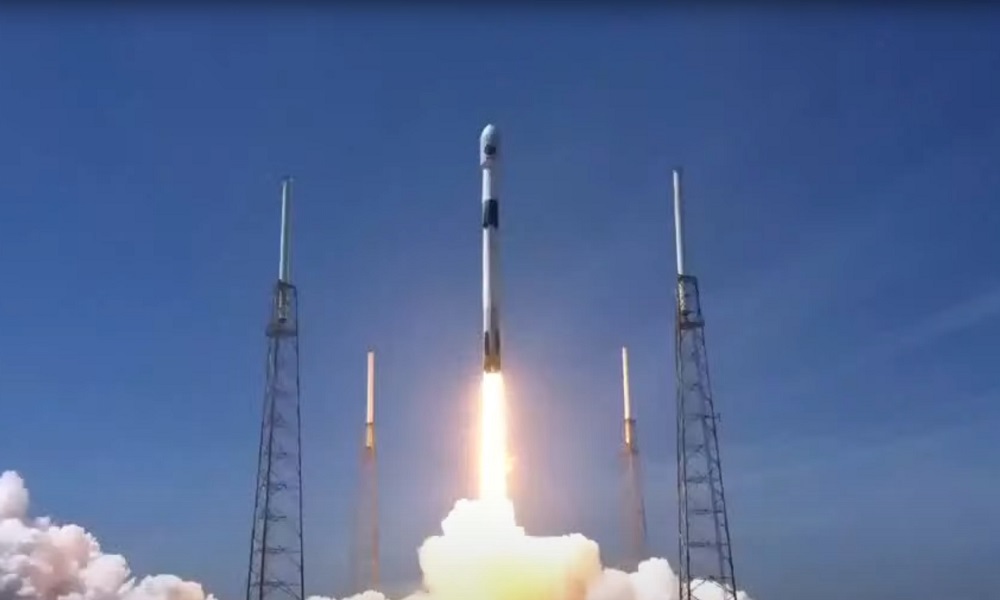Science & Technology
Europe’s Euclid space telescope launched on mission to explore ‘dark universe’

A European-built orbital satellite was launched to space on Saturday from Florida on a mission to shed new light on the mysterious cosmic phenomena known as dark energy and dark matter, unseen forces scientists say account for 95% of the known universe.
The telescope dubbed Euclid, named for the ancient Greek mathematician called the “father of geometry,” was carried aloft in the cargo bay of a SpaceX Falcon 9 rocket that blasted off around 11 a.m. EDT (1500 GMT) from Cape Canaveral Space Force Station.
A livestream of the liftoff was shown on NASA TV.
New insights from the $1.4 billion European Space Agency (ESA) mission, designed to last at least six years, are expected to transform astrophysics and perhaps understanding of the very nature of gravity itself.
Following a short flight to space, Euclid was to be released from the Falcon for a month-long voyage to its destination in solar orbit nearly 1 million miles (1.6 million km) from Earth – a position of gravitational stability between the Earth and sun called the Lagrange Point Two, or L2.
From there, Euclid is designed to explore the evolution of what astrophysicists refer to as the “dark universe,” using a wide-angle telescope to survey galaxies as far away as 10 billion light years from Earth across an immense expanse of the sky beyond our own Milky Way galaxy.
The 2-ton spacecraft is also equipped with instruments designed to measure the intensity and spectrums of infrared light from those galaxies in a way that will precisely determine their distances.
The mission focuses on two foundational components of the dark universe. One is dark matter, the invisible but theoretically influential cosmic scaffolding thought to give shape and texture to the cosmos. The other is dark energy, an equally enigmatic force believed to explain why expansion of the universe, as scientists learned in the 1990s, has long been accelerating.
The possibilities of the mission are reflected by the enormity of Euclid’s inquiry. Scientists estimate dark energy and dark matter together make up 95% of the cosmos, while ordinary matter that we can see accounts for just 5%.
Science & Technology
Ethiopian volcano erupts for first time in nearly 12,000 years
Ash from the eruption drifted across the region, spreading over Yemen, Oman, India, and parts of Pakistan.

The Hayli Gubbi volcano in Ethiopia’s Afar region has erupted for the first time in almost 12,000 years, sending massive ash plumes soaring up to 14 kilometres into the atmosphere, according to the Toulouse Volcanic Ash Advisory Centre.
The eruption began on Sunday and lasted several hours. Hayli Gubbi, located around 800 kilometres northeast of Addis Ababa near the Eritrean border, sits within the geologically active Rift Valley, where two major tectonic plates meet. The volcano rises roughly 500 metres above the surrounding landscape.
Ash from the eruption drifted across the region, spreading over Yemen, Oman, India, and parts of Pakistan. Satellite imagery and social-media videos captured a towering column of white smoke billowing into the sky.
The Smithsonian Institution’s Global Volcanism Program notes that Hayli Gubbi has no recorded eruptions during the Holocene, the period dating back about 12,000 years to the end of the last Ice Age.
Volcanologist Simon Carn of Michigan Technological University also confirmed on Bluesky that the volcano had “no record of Holocene eruptions.”
Science & Technology
Cloudflare outage easing after millions of internet users affected

A global outage at web-infrastructure firm Cloudflare began to ease on Tuesday afternoon after preventing people from accessing major internet platforms, including X and ChatGPT.
Cloudflare, whose network handles around a fifth of web traffic, said it started to investigate the internal service degradation around 6:40 a.m. ET. It has deployed a fix but some customers might still be impacted as it recovers service.
The incident marked the latest hit to major online services. An outage of Amazon’s cloud service last month caused global turmoil as thousands of popular websites and apps, including Snapchat, were inaccessible due to the disruption.
Cloudflare – whose shares were down about 5% in premarket trading – runs one of the world’s largest networks that helps websites and apps load faster and stay online by protecting them from traffic surges and cyberattacks.
The latest outage prevented users from accessing platforms such as Canva, X, and ChatGPT, prompting users to log outage reports with Downdetector.
Downdetector tracks outages by collating status reports from a number of sources. “We saw a spike in unusual traffic to one of Cloudflare’s services beginning at 11:20 UTC. That caused some traffic passing through Cloudflare’s network to experience errors,” the company said in an emailed statement.
“We are all hands on deck to make sure all traffic is served without errors.”
X and ChatGPT-creator OpenAI did not immediately respond to requests for comment. – REUTERS
Science & Technology
China sends its youngest astronaut to ‘Heavenly Palace’ space station

China’s Shenzhou-21 space rocket and its crew including the youngest member of its astronaut corps blasted off on Friday atop a Long March-2F rocket from the Jiuquan Satellite Launch Centre in northwest China, Chinese state media reported.
It was the seventh mission to the permanently inhabited Chinese space station since it was completed in 2022, Reuters reported.
Missions on China’s Shenzhou-21 spacecraft involve trios of astronauts on six-month stays in space, with veteran astronauts increasingly replaced by younger faces. First-timers Zhang Hongzhang, 39, and Wu Fei, 32 – China’s youngest astronaut to be sent to space – were picked to participate in the programme in 2020.
Commander Zhang Lu, 48, flew on the 2022 Shenzhou-15 mission.
FIRST SMALL MAMMALS ON SPACE STATION
The Shenzhou-21 astronauts will take over from the Shenzhou-20 crew who had lived and worked on board Tiangong, or “Heavenly Palace”, for more than six months. The Shenzhou-20 astronauts will return to Earth in the coming days.
The Shenzhou-21 crew were also joined by four black mice, the first small mammals to be taken to the Chinese space station. The mice will be used in experiments on reproduction in low Earth orbit.
Biannual launches have become the norm for the Shenzhou programme, which has in the past year reached new milestones with the deployment of Chinese astronauts born in the 1990s, a world-record spacewalk, and plans to train and send the first foreign astronaut, from Pakistan, to Tiangong next year.
The rapid advances have raised alarm bells in Washington, which is now racing to put a U.S. astronaut on the moon again before China does.
Both countries are also competing in nascent institution-building efforts, with the U.S.-led Artemis Accords on lunar exploration matched up against the Chinese and Russian-led International Lunar Research Station.
-

 Latest News5 days ago
Latest News5 days agoNew meeting between Afghanistan and Pakistan held in Saudi Arabia
-

 Health5 days ago
Health5 days agoHealth ministry holds meeting with envoys of international organizations in Kabul
-

 Latest News5 days ago
Latest News5 days ago1.5 million Afghans living with serious disabilities
-

 Business3 days ago
Business3 days agoAriana Afghan Airlines boost air trade with arrival of new cargo aircraft
-

 Latest News5 days ago
Latest News5 days agoMuttaqi highlights IEA’s restraint as tensions rise with Pakistan
-

 Sport5 days ago
Sport5 days agoACL: Sorkh Poshan Khafi 6–0 Istiqlal Kabul; Sarafan Herat, Sarsabz Yashlar draw 0–0
-

 Business4 days ago
Business4 days agoIEA demands assurances from Islamabad before trade routes reopen
-

 Latest News3 days ago
Latest News3 days agoIran offers fully funded virtual education for Afghan students returning from abroad
























